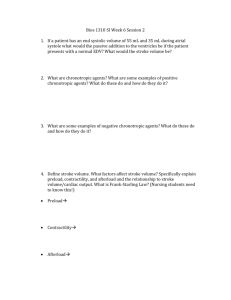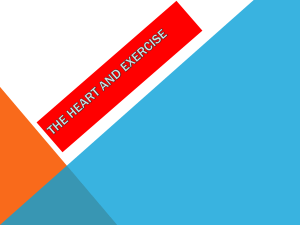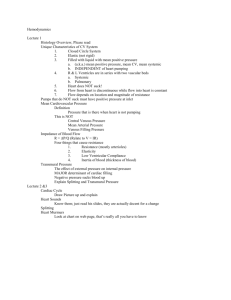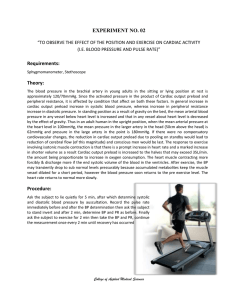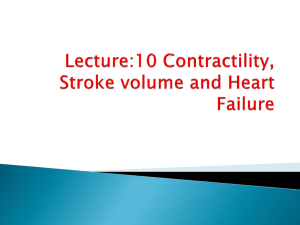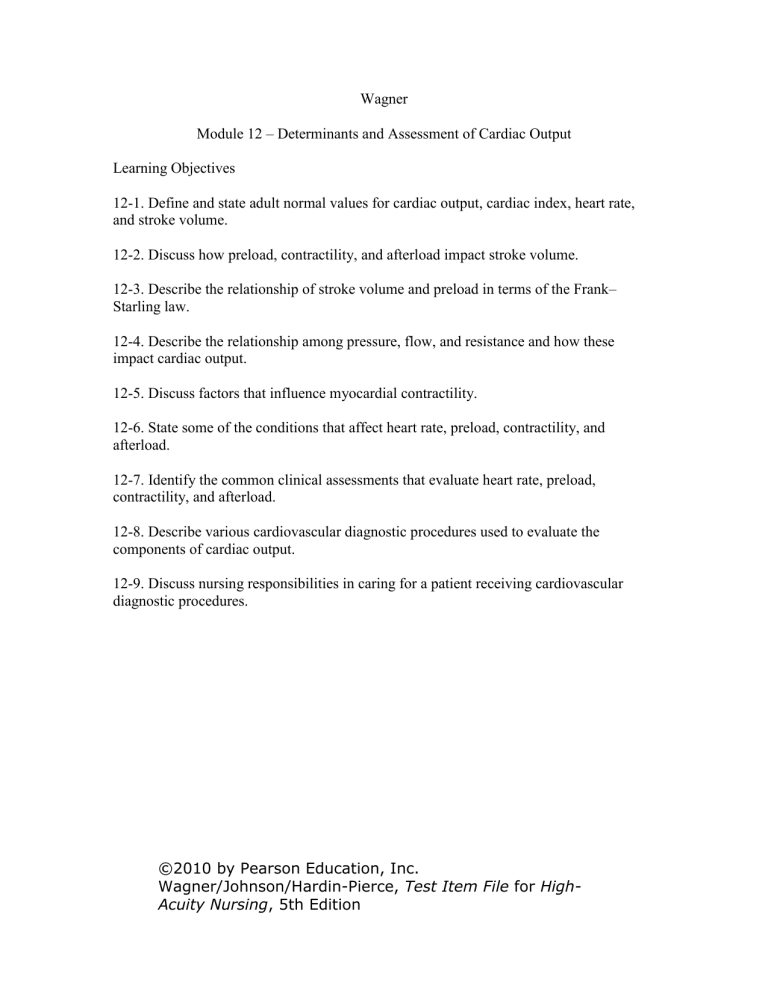
Wagner Module 12 – Determinants and Assessment of Cardiac Output Learning Objectives 12-1. Define and state adult normal values for cardiac output, cardiac index, heart rate, and stroke volume. 12-2. Discuss how preload, contractility, and afterload impact stroke volume. 12-3. Describe the relationship of stroke volume and preload in terms of the Frank– Starling law. 12-4. Describe the relationship among pressure, flow, and resistance and how these impact cardiac output. 12-5. Discuss factors that influence myocardial contractility. 12-6. State some of the conditions that affect heart rate, preload, contractility, and afterload. 12-7. Identify the common clinical assessments that evaluate heart rate, preload, contractility, and afterload. 12-8. Describe various cardiovascular diagnostic procedures used to evaluate the components of cardiac output. 12-9. Discuss nursing responsibilities in caring for a patient receiving cardiovascular diagnostic procedures. ©2010 by Pearson Education, Inc. Wagner/Johnson/Hardin-Pierce, Test Item File for HighAcuity Nursing, 5th Edition LO: 12-1. Define and state adult normal values for cardiac output, cardiac index, heart rate, and stroke volume. 1. The nurse is going to calculate the normal cardiac output for an adult patient. Which of the following will be needed to make this calculation? 1. age 2. height 3. body surface area 4. weight Answer: 3 Rationale: Cardiac output is most affected by body size. Age alone does not necessarily influence cardiac output. The most accurate influence for cardiac output is not height independently, nor weight independently, but together proportionately height and weight have an impact on cardiac output. Therefore, the correct answer is body surface area because this considers both height and weight in combination for a patient. Cognitive Level: Applying Nursing Process: Assessment Client Need: Physiological Integrity ©2010 by Pearson Education, Inc. Wagner/Johnson/Hardin-Pierce, Test Item File for HighAcuity Nursing, 5th Edition LO: 12-1. Define and state adult normal values for cardiac output, cardiac index, heart rate, and stroke volume. 2. The nurse is concerned about a patient’s cardiac output. Which of the following will help the nurse determine this patient’s cardiac output? 1. as stroke volume decreases and heart rate increases 2. as stroke volume decreases and heart rate decreases 3. as stroke volume increases and heart rate increases 4. as stroke volume maintains and heart rate maintains Answer: 1 Rationale: Stroke volume and heart rate form an interrelationship to keep cardiac output at the level needed by the body. This is a compensatory mechanism that is an inverse relationship. If the stroke volume decreases, the heart rate increases to compensate. If the heart rate decreases, the stroke volume increases to compensate. Cognitive Level: Analyzing Nursing Process: Assessment Client Need: Physiological Integrity ©2010 by Pearson Education, Inc. Wagner/Johnson/Hardin-Pierce, Test Item File for HighAcuity Nursing, 5th Edition LO: 12-2. Discuss how preload, contractility, and afterload impact stroke volume. 1. A patient is having an echocardiogram with measurement of ejection fraction. The nurse realizes this diagnostic test will evaluate which of the following cardiac characteristics? 1. preload 2. afterload 3. contractility 4. cardiac output Answer: 3 Rationale: Contractility is defined as the force of myocardial contraction and reflects the ability of the heart muscle to work independently of preload and afterload; the ability to function as a pump. Ejection fraction is a measure of the percent of blood ejected with each stroke volume and is used as an index of myocardial function. The ejection fraction is the stroke volume divided by end diastolic volume. A normal ejection fraction is 60 percent. The ejection fraction does not evaluate preload, afterload, or cardiac output. Cognitive Level: Analyzing Nursing Process: Assessment Client Need: Physiological Integrity ©2010 by Pearson Education, Inc. Wagner/Johnson/Hardin-Pierce, Test Item File for HighAcuity Nursing, 5th Edition LO: 12-2. Discuss how preload, contractility, and afterload impact stroke volume. 2. It has been determined that a patient has a high preload. Which of the following will occur with this patient? 1. stroke volume will be low 2. stroke volume will be high 3. stroke volume will be unchanged 4. afterload will increase Answer: 2 Rationale: The greater the volume of blood in the ventricle, the greater the amount of stretch that the fibers experience. Preload is greatly affected by the volume of blood delivered to the heart from the venous system. If a large volume of blood returns from the venous system to the ventricle, the myocardial fibers will be stretched so that they are far apart. This represents a high preload. High preload corresponds to high volume; low preload corresponds to low volume. If afterload increases, stroke volume decreases. Cognitive Level: Analyzing Nursing Process: Assessment Client Need: Physiological Integrity ©2010 by Pearson Education, Inc. Wagner/Johnson/Hardin-Pierce, Test Item File for HighAcuity Nursing, 5th Edition LO: 12-3. Describe the relationship of stroke volume and preload in terms of the Frank– Starling law. 1. The nurse is caring for a patient with an increasing preload. The nurse realizes that which of the following will occur with this increase in preload? 1. stroke volume will decrease 2. stroke volume will not be affected 3. stroke volume will increase only if the heart rate increases 4. stroke volume will increase Answer: 4 Rationale: Within limits, the heart pumps the amount of blood it receives with each beat. This is known as the Frank–Starling Law of the heart. In other words, as preload increases, so will stroke volume, and as preload decreases, stroke volume falls. The patient with an increasing preload will have an increase in stroke volume. The other choices are incorrect. Cognitive Level: Analyzing Nursing Process: Assessment Client Need: Physiological Integrity ©2010 by Pearson Education, Inc. Wagner/Johnson/Hardin-Pierce, Test Item File for HighAcuity Nursing, 5th Edition LO: 12-3. Describe the relationship of stroke volume and preload in terms of the Frank– Starling law. 2. A patient, with a steadily increasing preload was experiencing a corresponding increase in stroke volume but it has now begun to decrease. The nurse realizes that which of the following is occurring in this patient? 1. maximum preload has yet to be reached 2. there is something else going on with the patient that is effecting the stroke volume 3. the heart rate is increasing which is causing the drop in stroke volume 4. preload has reached the critical point and now stroke volume will decrease Answer: 4 Rationale: Until a critical point is reached, as preload increases, so does stroke volume. An optimal preload leads to an optimal stroke volume. Once past this point, an increase in preload results in a decrease in stroke volume. If the heart receives too much preload, it cannot effectively pump out that volume and stroke volume decreases. Stroke volume decreases because too much volume causes excessive stretching of the myocardial fibers and the ventricles cannot effectively contract. There is not something else going on with the patient that is affecting the stroke volume. There is no evidence to suggest that the patient’s heart rate is increasing. Cognitive Level: Analyzing Nursing Process: Assessment Client Need: Physiological Integrity ©2010 by Pearson Education, Inc. Wagner/Johnson/Hardin-Pierce, Test Item File for HighAcuity Nursing, 5th Edition LO: 12-4. Describe the relationship among pressure, flow, and resistance and how these impact cardiac output. 1. A patient is admitted to the intensive care unit with a diagnosis of hypertension. The nurse realizes that which of the following is occurring with this patient’s cardiac afterload? 1. afterload is increased, cardiac output decreases, and blood pressure increases 2. afterload is decreased, cardiac output decreases, and blood pressure increases 3. afterload is increased, cardiac output increases, and blood pressure increases 4. afterload is decreased, cardiac output increases, and blood pressure stays the same. Answer: 1 Rationale: Afterload is increased, cardiac output decreases, and blood pressure increases is the correct answer. Afterload is the resistance against which the ventricle must pump blood. If afterload increases, stroke volume must decrease. Therefore, this causes the blood pressure to increase. The flow and resistance compensate to maintain the pressure, just as the stroke volume and the heart rate compensate to maintain the cardiac output. Afterload is decreased, cardiac output decreases, and blood pressure increases is an incorrect choice because if the afterload is decreased, the cardiac output must increase. Afterload is increased, cardiac output increases, and blood pressure increases is an incorrect choice because the cardiac output would decrease if afterload is increased. Afterload is decreased, cardiac output increases, and blood pressure stays the same is an incorrect choice because the blood pressure would increase if afterload is decreased and cardiac output increases. Cognitive Level: Analyzing Nursing Process: Assessment Client Need: Physiological Integrity ©2010 by Pearson Education, Inc. Wagner/Johnson/Hardin-Pierce, Test Item File for HighAcuity Nursing, 5th Edition LO: 12-4. Describe the relationship among pressure, flow, and resistance and how these impact cardiac output. 2. A patient is diagnosed with septic shock and has a decrease in afterload. The nurse realizes that which of the following is occurring with this patient? 1. increase in cardiac output and decrease in blood pressure 2. decrease in cardiac output and increase in blood pressure 3. increase in cardiac output and increase in blood pressure 4. decrease in cardiac output and decrease in blood pressure Answer: 1 Rationale: Blood pressure is the product of cardiac output and afterload. When afterload decreases, cardiac output increases and blood pressure decreases. This is what happens to patients diagnosed with septic shock. When afterload increases, cardiac output decreases and blood pressure increases. This is what happens to patients with hypertension. The other two choices do not correlate with the diagnosis of septic shock. Cognitive Level: Analyzing Nursing Process: Assessment Client Need: Physiological Integrity ©2010 by Pearson Education, Inc. Wagner/Johnson/Hardin-Pierce, Test Item File for HighAcuity Nursing, 5th Edition LO: 12-5. Discuss factors that influence myocardial contractility. 1. The patient with congestive heart failure has oxygen prescribed as needed. In which of the following situations would oxygen be needed to prevent hypoxemia in the patient? 1. conducting passive range of motion on the patient 2. having a quiet conversation with a clergy member 3. assisting the patient with self-care activities 4. while taking a midday nap. Answer: 3 Rationale: The patient needs additional oxygen when doing any activity that increases the work of the heart. Hypoxemia is a negative inotrope and will reduce the contractility of the heart. When the patient is at rest, the load on the heart would decrease and, therefore, the need for oxygen would decrease. Having a quiet conversation with a clergy member and having passive range of motion will also not increase the oxygen demands on the heart or cause hypoxemia. Cognitive Level: Analyzing Nursing Process: Implementation Client Need: Physiological Integrity ©2010 by Pearson Education, Inc. Wagner/Johnson/Hardin-Pierce, Test Item File for HighAcuity Nursing, 5th Edition LO: 12-5. Discuss factors that influence myocardial contractility. 2. It is determined that a patient has poor cardiac contractility. The nurse realizes that which of the following medications would help this patient? 1. hydralazine 2. digoxin 3. hydrochlorothiazide 4. Aldomet Answer: 2 Rationale: Factors that increase myocardial contractility have a positive inotropic effect. Positive inotropes include sympathetic nervous system stimulation, increased calcium release, and the administration of inotropic drugs, such as digoxin and dobutamine. The other medication choices are not considered positive inotropes. Cognitive Level: Analyzing Nursing Process: Assessment Client Need: Physiological Integrity ©2010 by Pearson Education, Inc. Wagner/Johnson/Hardin-Pierce, Test Item File for HighAcuity Nursing, 5th Edition LO: 12-6. State some of the conditions that affect heart rate, preload, contractility, and afterload. 1. A patient is prescribed a beta-blocker. The nurse realizes that which of the following will occur in this patient? 1. increased blood pressure 2. decreased preload 3. increased contractility 4. decreased heart rate Answer: 4 Rationale: Heart rate may be slowed by administration of drugs that block sympathetic activity such as beta-blockers. Medications that block sympathetic activity will decrease the blood pressure. Decreased preload is seen in hemorrhage, dehydration, diuretic use, atrioventricular valve malfunction, vasodilation of the venous system, and a rapid heart rate. Parasympathetic nerve stimulation will cause decreased contractility and not increased contractility. Cognitive Level: Analyzing Nursing Process: Assessment Client Need: Physiological Integrity ©2010 by Pearson Education, Inc. Wagner/Johnson/Hardin-Pierce, Test Item File for HighAcuity Nursing, 5th Edition LO: 12-6. State some of the conditions that affect heart rate, preload, contractility, and afterload. 2. A patient is diagnosed with aortic valve stenosis. Which of the following will this valve disorder effect? 1. afterload 2. heart rate 3. preload 4. contractility Answer: 1 Rationale: The major determinant of afterload is the resistance to flow caused by the arterial system. Resistance to flow can be caused by failure of the pulmonic or aortic valve to allow free flow of blood from the ventricle to the artery. In this case, the stenosed valve causes an increase in afterload. The stenosis will not affect heart rate, preload, or contractility. Cognitive Level: Analyzing Nursing Process: Assessment Client Need: Physiological Integrity ©2010 by Pearson Education, Inc. Wagner/Johnson/Hardin-Pierce, Test Item File for HighAcuity Nursing, 5th Edition LO: 12-7. Identify the common clinical assessments that evaluate heart rate, preload, contractility, and afterload. 1. A patient is admitted with the complaint of chest pain. Which of the following must the nurse assess to discriminate between pain of cardiac origin and that of pulmonary origin? 1. sensations of loss, timing, and diet 2. precipitating factors, quality, and location 3. home remedies, bedrest, and diet 4. dietary habits, smoking, and cough history Answer: 2 Rationale: The pain assessment will include the following factors: quality, radiation and region (location), associated symptoms, and timing and treatment strategies. Precipitating factors, quality, and location includes those characteristics, whereas the other choices include diet, extraneous factors, and risk factors which are not included when discriminating between pain of cardiac origin from that of a pulmonary origin. Cognitive Level: Applying Nursing Process: Assessment Client Need: Physiological Integrity ©2010 by Pearson Education, Inc. Wagner/Johnson/Hardin-Pierce, Test Item File for HighAcuity Nursing, 5th Edition LO: 12-7. Identify the common clinical assessments that evaluate heart rate, preload, contractility, and afterload. 2. The nurse will use which of the following physical assessment techniques when assessing a patient for cardiac output? 1. inspection, percussion, auscultation 2. inspection, palpation, percussion 3. inspection, palpation, diaphragmatic excursion 4. inspection, auscultation, palpation Answer: 4 Rationale: The techniques for physical assessment of cardiac output include inspection, palpation, and auscultation. Percussion is incorrect because it measures heart size very crudely but not output. Inspection, palpation, diaphragmatic excursion is incorrect because diaphragmatic excursion measures lung expansion. Cognitive Level: Applying Nursing Process: Assessment Client Need: Physiological Integrity ©2010 by Pearson Education, Inc. Wagner/Johnson/Hardin-Pierce, Test Item File for HighAcuity Nursing, 5th Edition LO: 12-7. Identify the common clinical assessments that evaluate heart rate, preload, contractility, and afterload. 3. A patient has been admitted with chest pain and generalized discomfort. Which of the following assessment data will assist the nurse in setting realistic goals for patient therapy and education? 1. demographic data including age, sex, race, and weight of patient 2. knowledge of the patient’s functional status prior to illness 3. cardiovascular risk factors, such as history of smoking and stress level 4. family history of disease, diet history, and prior medical history Answer: 2 Rationale: Knowledge of the patient’s functional status prior to illness assists the nurse in setting goals that are realistic for the patient. The other data to be collected such as demographic data, risk factors, and family conditions are all data that should be obtained during the history but do not assist the nurse in setting realistic goals. Cognitive Level: Applying Nursing Process: Assessment Client Need: Physiological Integrity ©2010 by Pearson Education, Inc. Wagner/Johnson/Hardin-Pierce, Test Item File for HighAcuity Nursing, 5th Edition LO: 12-7. Identify the common clinical assessments that evaluate heart rate, preload, contractility, and afterload. 4. The nurse is conducting a detailed patient history on a patient admitted with a cardiac disorder. Which of the following assessment data will help identify the patient’s cardiovascular risk factors? 1. patient eats a vegetarian diet 2. patient is 6 feet 4 inches tall and weighs 185 pounds 3. patient quit smoking 5 years ago 4. patient has no previous health problems Correct Answers: 3 Rationale: Cardiovascular risk factors, such as exercise pattern, obesity, smoking history, and stress level, must be assessed. Quitting smoking identifies a smoking history, and therefore is the correct response. Patient is 6 feet 4 inches tall and weighs 185 pounds does not identify an obese patient; patient eats a vegetarian diet only gives information about the patient’s diet, not a risk associated with high cholesterol or other factors; and patient has no previous health problems does not indicate any other health problems. Cognitive Level: Applying Nursing Process: Assessment Client Need: Physiological Integrity ©2010 by Pearson Education, Inc. Wagner/Johnson/Hardin-Pierce, Test Item File for HighAcuity Nursing, 5th Edition LO: 12-7. Identify the common clinical assessments that evaluate heart rate, preload, contractility, and afterload. 5. After auscultating a patient’s heart sounds and measuring vital signs, the nurse determines that which of the following assessment findings needs additional assessment? 1. split of S2 2. bounding, vigorous pulse 3. pulse pressure of 30 to 40 mm hg 4. apical pulse of 60 to 80 Answer: 1 Rationale: The split of S2 indicates that one ventricle is emptying earlier or later than another and that contractility may, therefore, be diminished. This would indicate the need for further assessment and is the correct answer. Pulse pressure is defined as the difference between diastolic and systolic blood pressure. The pulse pressure reflects how much the heart is able to raise the pressure in the arterial system with each beat. Pulse pressure of 30 to 40 mm Hg does not indicate cause for concern because it is within the normal pulse pressure range. Apical pulse of 60 to 80 is within normal limits also. Increased contractility is recognized in a bounding, vigorous pulse and, therefore, not cause for alarm. Cognitive Level: Applying Nursing Process: Assessment Client Need: Physiological Integrity ©2010 by Pearson Education, Inc. Wagner/Johnson/Hardin-Pierce, Test Item File for HighAcuity Nursing, 5th Edition LO: 12-7. Identify the common clinical assessments that evaluate heart rate, preload, contractility, and afterload. 6. A patient is admitted with a decrease in cardiac output. Which of the following assessment findings are consistent with this diagnosis? 1. 2. 3. 4. increased urine output warm skin temperature changes in skin color localized edema in the calf Correct Answers: 3 Rationale: Changes in skin color can be a sign of hemodynamic compromise and a decrease in cardiac output. Warm skin temperature is a normal finding, whereas cool distal extremities would be an indicator of decreased cardiac output. A decrease in cardiac output generally results in a decrease in urine output. Localized edema in the calf is indicative of obstruction of venous blood flow from a clot in a leg vein. Generalized edema is associated with congestive heart failure. Cognitive Level: Analyzing Nursing Process: Assessment Client Need: Physiological Integrity ©2010 by Pearson Education, Inc. Wagner/Johnson/Hardin-Pierce, Test Item File for HighAcuity Nursing, 5th Edition LO: 12-7. Identify the common clinical assessments that evaluate heart rate, preload, contractility, and afterload. 7. A patient is being assessed for myocardial damage. Which of the following diagnostic tests will provide the most information about the patient’s heart? 1. creatine kinase level 2. BNP level 3. electrolytes 4. troponin level Answer: 4 Rationale: Troponin is a protein found in cardiac muscle and can appear in the blood as early as 3 to 4 hours after myocardial damage. Troponin has a higher sensitivity and specificity for identifying even minor necrosis than CK-MB. The higher the troponin level and/or the longer the troponin levels remain elevated, the greater the size of myocardial damage and the severity of injury. BNP level is assessed for the presence of heart failure. Electrolytes are important to assess but will not provide the most information about the patient’s heart damage. Cognitive Level: Applying Nursing Process: Assessment Client Need: Physiological Integrity ©2010 by Pearson Education, Inc. Wagner/Johnson/Hardin-Pierce, Test Item File for HighAcuity Nursing, 5th Edition LO: 12-7. Identify the common clinical assessments that evaluate heart rate, preload, contractility, and afterload. 8. A patient is at risk for decreased right heart preload. The nurse realizes that which of the following findings would impact the patient’s safety? 1. patient experiences dry flaky skin 2. patient experiences dry mucous membranes 3. patient experiences dizziness on rising to a sitting position 4. patient has no peripheral edema Answer: 3 Rationale: The signs of decreased right heart preload are poor skin turgor, dry mucous membranes, orthostatic hypotension, and flat jugular veins. Dizziness, dry skin, and dry mucous membranes are all correct assessments for the condition. However, the patient experiencing dizziness on rising to a sitting position indicates orthostatic hypotension, which puts the patient at risk for falls and fainting and, therefore, is the choice that impacts the patient’s safety. Cognitive Level: Analyzing Nursing Process: Assessment Client Need: Physiological Integrity ©2010 by Pearson Education, Inc. Wagner/Johnson/Hardin-Pierce, Test Item File for HighAcuity Nursing, 5th Edition LO: 12-8. Describe various cardiovascular diagnostic procedures used to evaluate the components of cardiac output. 1. The nurse is instructing a patient who is scheduled for a cardiac catheterization. Which of the following comments made by the patient would indicate the need for additional education? 1. “I will place a warm pack at the puncture site for pain relief.” 2. “I will bring someone with me to drive me home following the procedure.” 3. “I will not be able to go upstairs to my bedroom for 72 hours.” 4. “I will not be able to take a bath for 7 days.” Answer: 1 Rationale: Cardiac catheterization is performed to determine the patency of the coronary vessels and to observe the blood flow through the chambers and the valves. This procedure is conducted via the arterial system and the most common insertion site is the femoral artery. Complications of this procedure can include hematoma, bleeding, and pseudoaneurysm. Driving, bathing, and climbing stairs should be avoided for 72 hours to reduce the chance of rupture at the insertion site. The puncture site should not be submerged for 7 days to reduce the chances of infection. The vasodilatory effect of a warm pack would cause vessel rupture and, therefore, is the choice that indicates a need for further education. Cognitive Level: Analyzing Nursing Process: Evaluation Client Need: Physiological Integrity ©2010 by Pearson Education, Inc. Wagner/Johnson/Hardin-Pierce, Test Item File for HighAcuity Nursing, 5th Edition LO: 12-8. Describe various cardiovascular diagnostic procedures used to evaluate the components of cardiac output. 2. A patient is admitted with a cardiac arrhythmia. Which of the following diagnostic tests will help in the diagnosis of this patient’s cardiac disorder? 1. cardiac catheterization 2. electrophysiology study 3. echocardiogram 4. exercise electrocardiogram Answer: 2 Rationale: The electrophysiology study is an invasive procedure that evaluates the cardiac conduction system and helps classify cardiac arrhythmias. The findings from this study help to determine if the patient would benefit from further interventions such as a pacemaker, implantable cardiodefibrillator, and radiofrequency ablation or medication therapy. Cardiac catheterization is performed to determine the presence and extent of coronary artery disease, evaluate left ventricular function, and to evaluate valvular or myocardial disorders. Echocardiograms are used to visualize blood, cardiac valves, the myocardium, and the pericardium. Exercise electrocardiograms evaluate heart muscle and its blood supply during physical stress. Cognitive Level: Applying Nursing Process: Assessment Client Need: Physiological Integrity ©2010 by Pearson Education, Inc. Wagner/Johnson/Hardin-Pierce, Test Item File for HighAcuity Nursing, 5th Edition LO: 12-9. Discuss nursing responsibilities in caring for a patient receiving cardiovascular diagnostic procedures. 1. A patient is scheduled for an exercise electrocardiogram. Which of the following will the nurse ensure is present in the room while the test is being conducted? 1. external pacemaker 2. portable chest x-ray machine 3. oral fluids 4. emergency medications and a defibrillator Answer: 4 Rationale: Emergency medications and a defibrillator should be present in the room during an exercise electrocardiogram test. External pacemakers, portable chest x-ray machines, and oral fluids are not indicated to be present in the room during an exercise electrocardiogram. Cognitive Level: Applying Nursing Process: Planning Client Need: Physiological Integrity ©2010 by Pearson Education, Inc. Wagner/Johnson/Hardin-Pierce, Test Item File for HighAcuity Nursing, 5th Edition LO: 12-9. Discuss nursing responsibilities in caring for a patient receiving cardiovascular diagnostic procedures. 2. The nurse is caring for a patient having a TEE. Which of the following is an appropriate nursing intervention for the care of this patient? 1. monitor for bradycardia and hypotension after the procedure 2. dim the lights in the room 3. apply pressure to the puncture site 4. assess pedal pulses bilaterally Answer: 1 Rationale: The TEE is done under conscious sedation. After the procedure, the nurse needs to assess for bradycardia and hypotension because of possible stimulation of the patient’s vagus nerve. Dimming the lights in the room would be appropriate for a transthoracic echocardiogram. Applying pressure to the puncture site and assessing pedal pulses would be appropriate after a cardiac catheterization. Cognitive Level: Applying Nursing Process: Implementation Client Need: Physiological Integrity ©2010 by Pearson Education, Inc. Wagner/Johnson/Hardin-Pierce, Test Item File for HighAcuity Nursing, 5th Edition
